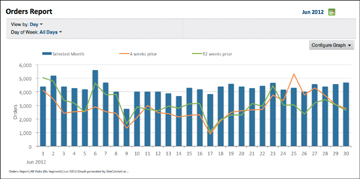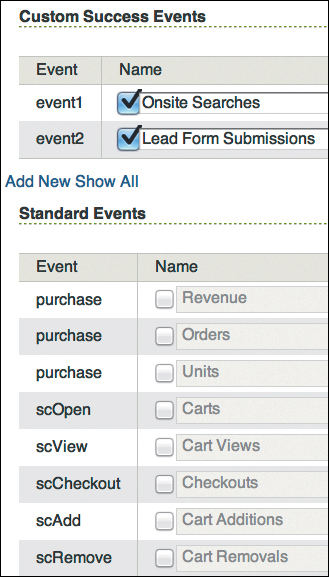Understanding Success Events
Recall in the discussion of traffic variables (sProps) in the previous chapter that those variables stored values like page names or the names of professional boxers. This is not possible with success events, because they can only store numbers. In fact, success events are more akin to the traffic metrics discussed in Chapter 3, which included page views, visits, and unique visitors. Eventually, when you start to master SiteCatalyst, you’ll realize that these traffic metrics are similar to success events but are predefined by SiteCatalyst. In contrast, success events are metrics that you choose to collect. In fact, starting with SiteCatalyst v15, many traffic metrics, such as page views, visits, and unique visitors, are also available in the conversion part of the product. In some respects, the lines between the traffic and conversion parts of the product are beginning to blur, but I’ll discuss that in more detail in later chapters. For now, just remember that success events are metrics that you choose, and they can only collect numbers.
In general, success events collect data when a visitor takes an action on the website. This action can be a button click or simply loading a specific page. Often, success events are set on the page following the action taken by the visitor. For example, when a visitor adds an item to the shopping cart, the success event might be set on the subsequent shopping cart page. When you send data to a success event, SiteCatalyst records the date and time that the event took place, and creates a report for each success event that shows you these numbers by date (hour, day, week, etc.). This metric report will look pretty much the same for every success event you have, only the actual numbers will be different (Figure 4.1, on the next page).

Figure 4.1. Sample success event report.
Each success event that you want to capture is assigned to its own success event number in the administration console. It’s important to use the correct success event number when you’re setting success events in your code, or else the numbers in your success event reports will be incorrect. You can also use the administration console to create “friendly” names for each success event. This is better than forcing your end users to remember that “Event 1” is onsite searches or that “Event 2” is lead form submissions. Note that there are some predefined shopping cart success events in the administration console (Figure 4.2). These predefined shopping cart success events (Orders, Revenue, Cart Additions, etc.) are similar to the predefined traffic variables you saw for page name and site section. They function the same as custom success events that you choose but are simply predefined because many websites tend to use them.

Figure 4.2. Success events in the administration console.
Shopping Cart Success Events
The following sections explain the predefined shopping cart success events in more detail.
Revenue, Orders, Units (purchase)
The Purchase event in SiteCatalyst is unique in that it populates three distinct success event metrics: Revenue, Orders, and Units. This event is set in combination with the products variable, which is discussed in a later chapter. For now, all you need to know is that when you set the Purchase event (often on the order confirmation page), SiteCatalyst will use values you pass to the products variable to determine how much was spent (Revenue) and how many items were ordered (Units), and will count one successful Order.
Carts (scOpen)
The Carts (scOpen) success event is intended to represent how many shopping carts are created or opened during the specified time frame. Some websites open the shopping cart each time a product is added to it. In this scenario, the Carts success event will be set at the same time as the Cart Additions (scAdd) success event, but the Carts success event should be set only once during the visit.
Cart Views (scView)
The Cart Views (scView) success event represents the number of times visitors have viewed their cart during the specified time period.
Checkouts (scCheckout)
The Checkouts (scCheckout) success event is set when visitors reach the checkout stage of the shopping cart, which is normally the step directly before a purchase takes place.
Cart Additions (scAdd)
The Cart Additions (scAdd) success event is set when visitors add products to the shopping cart.
Cart Removals (scRemove)
The Cart Removals (scRemove) success event is set when visitors remove items from their shopping cart. In reality, very few clients use this event because its data is questionable due to the fact that many website visitors don’t take the time to physically remove cart items, choosing instead to simply leave items in the shopping cart when exiting the website.
Product Views (prodView)
The Product Views (prodView) success event doesn’t appear in the administration console but is meant to be set when visitors view a product detail page on the website. There are some slight issues with this success event, which are covered in a later chapter, but it should be set and is often mistakenly omitted by SiteCatalyst customers.
As mentioned previously, these success events are simply predefined but can be used for any purpose. If your website doesn’t have a shopping cart, but does have a conversion funnel similar to a shopping cart, feel free to adapt these success events to your business model.